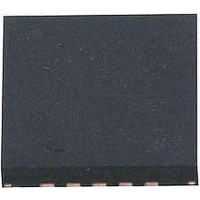ATTINY25-15MZ Atmel, ATTINY25-15MZ Datasheet - Page 81

ATTINY25-15MZ
Manufacturer Part Number
ATTINY25-15MZ
Description
MCU AVR 2K FLASH 15MHZ 20-QFN
Manufacturer
Atmel
Series
AVR® ATtinyr
Datasheet
1.ATTINY25-15MZ.pdf
(196 pages)
Specifications of ATTINY25-15MZ
Package / Case
20-QFN
Voltage - Supply (vcc/vdd)
2.7 V ~ 5.5 V
Operating Temperature
-40°C ~ 125°C
Speed
16MHz
Number Of I /o
6
Eeprom Size
128 x 8
Core Processor
AVR
Program Memory Type
FLASH
Ram Size
128 x 8
Program Memory Size
2KB (2K x 8)
Data Converters
A/D 4x10b
Oscillator Type
Internal
Peripherals
Brown-out Detect/Reset, POR, PWM, WDT
Connectivity
USI
Core Size
8-Bit
Processor Series
ATTINY2x
Core
AVR8
Data Bus Width
8 bit
Data Ram Size
128 B
Interface Type
UART, SPI, USI
Maximum Clock Frequency
16 MHz
Number Of Programmable I/os
6
Number Of Timers
2
Maximum Operating Temperature
+ 85 C
Mounting Style
SMD/SMT
3rd Party Development Tools
EWAVR, EWAVR-BL
Development Tools By Supplier
ATAVRDRAGON, ATSTK500, ATSTK600, ATAVRISP2, ATAVRONEKIT
Minimum Operating Temperature
- 40 C
On-chip Adc
10 bit, 4 Channel
Data Rom Size
128 B
A/d Bit Size
10 bit
A/d Channels Available
4
Height
0.75 mm
Length
4 mm
Supply Voltage (max)
5.5 V
Supply Voltage (min)
2.7 V
Width
4 mm
Lead Free Status / RoHS Status
Lead free / RoHS Compliant
- Current page: 81 of 196
- Download datasheet (4Mb)
14. Counter and Compare Units
14.1
7598H–AVR–07/09
Timer/Counter1
Figure 14-1
nous clocking mode and an asynchronous clocking mode. The synchronous clocking mode uses
the system clock (CK) as the clock timebase and asynchronous mode uses the fast peripheral
clock (PCK) as the clock time base. The PCKE bit from the PLLCSR register enables the asyn-
chronous mode when it is set (‘1’).
Figure 14-1. Timer/Counter1 Prescaler
In the asynchronous clocking mode the clock selections are from PCK to PCK/16384 and stop,
and in the synchronous clocking mode the clock selections are from CK to CK/16384 and stop.
The clock options are described in
ister, TCCR1. Setting the PSR1 bit in GTCCR register resets the prescaler. The PCKE bit in the
PLLCSR register enables the asynchronous mode. The frequency of the fast peripheral clock is
64 MHz (or 32 MHz in Low Speed Mode).
The Timer/Counter1 general operation is described in the asynchronous mode and the opera-
tion in the synchronous mode is mentioned only if there are differences between these two
modes.
chronization delays in between registers. Note that all clock gating details are not shown in the
figure. The Timer/Counter1 register values go through the internal synchronization registers,
which cause the input synchronization delay, before affecting the counter operation. The regis-
ters TCCR1, GTCCR, OCR1A, OCR1B, and OCR1C can be read back right after writing the
register. The read back values are delayed for the Timer/Counter1 (TCNT1) register and flags
(OCF1A, OCF1B, and TOV1), because of the input and output synchronization.
The Timer/Counter1 features a high resolution and a high accuracy usage with the lower pres-
caling opportunities. It can also support two accurate, high speed, 8-bit Pulse Width Modulators
using clock speeds up to 64 MHz ( or 32 MHz in Low Speed Mode). In this mode,
Timer/Counter1 and the output compare registers serve as dual stand-alone PWMs with
non-overlapping non-inverted and inverted outputs. Refer to
on this function. Similarly, the high prescaling opportunities make this unit useful for lower speed
functions or exact timing functions with infrequent actions.
CK
PCKE
PCK 64/32 MHz
Figure 14-2
shows the Timer/Counter1 prescaler that supports two clocking modes, a synchro-
CS10
CS11
CS12
CS13
S
A
shows Timer/Counter 1 synchronization register block diagram and syn-
PSR1
T1CK
0
Table 14-2 on page 84
TIMER/COUNTER1 COUNT ENABLE
T/C PRESCALER
14-BIT
and the Timer/Counter1 Control Reg-
page 90
ATtiny25/45/85
for a detailed description
81
Related parts for ATTINY25-15MZ
Image
Part Number
Description
Manufacturer
Datasheet
Request
R

Part Number:
Description:
Manufacturer:
Atmel Corporation
Datasheet:

Part Number:
Description:
Manufacturer:
Atmel Corporation
Datasheet:

Part Number:
Description:
IC MCU AVR 2K FLASH 20MHZ 20-QFN
Manufacturer:
Atmel
Datasheet:

Part Number:
Description:
IC AVR MCU 2K 20MHZ 8-DIP
Manufacturer:
Atmel
Datasheet:

Part Number:
Description:
IC AVR MCU 2K 20MHZ 8-SOIC
Manufacturer:
Atmel
Datasheet:

Part Number:
Description:
8-bit Microcontrollers - MCU AVR 16KB FL 512B EE 1KB SRAM 10 MHZ GRN
Manufacturer:
Atmel

Part Number:
Description:
8-bit Microcontrollers - MCU AVR 16KB FL 512B EE 1KB SRAM 10 MHZ GRN
Manufacturer:
Atmel

Part Number:
Description:
MCU AVR 2K ISP FLASH 2.7V 8-SOIC
Manufacturer:
Atmel
Datasheet:

Part Number:
Description:
MCU AVR 2KB FLASH 20MHZ 8SOIC
Manufacturer:
Atmel
Datasheet:

Part Number:
Description:
IC MCU AVR 2KB FLASH 20MHZ 8SOIC
Manufacturer:
Atmel
Datasheet:

Part Number:
Description:
IC MCU AVR 2KB FLASH 20MHZ 8SOIC
Manufacturer:
Atmel
Datasheet:

Part Number:
Description:
MCU AVR 2KB FLASH 20MHZ 8SOIC
Manufacturer:
Atmel
Datasheet:

Part Number:
Description:
MCU AVR 2KB FLASH 20MHZ 8SOIC
Manufacturer:
Atmel
Datasheet:

Part Number:
Description:
MCU AVR 2KB FLASH 20MHZ 20QFN
Manufacturer:
Atmel
Datasheet:











